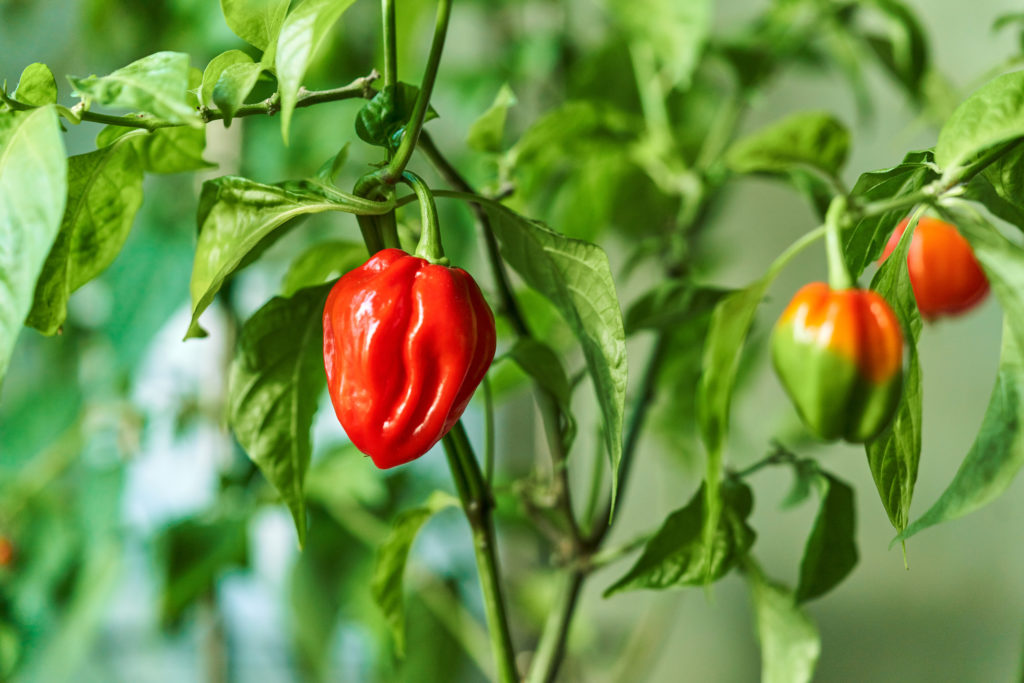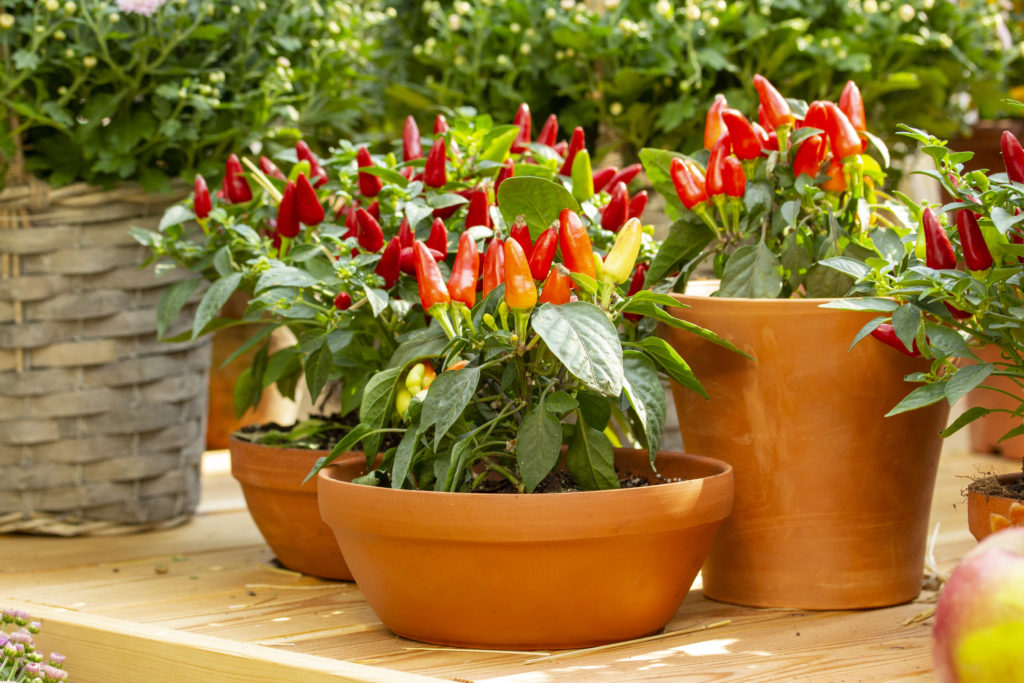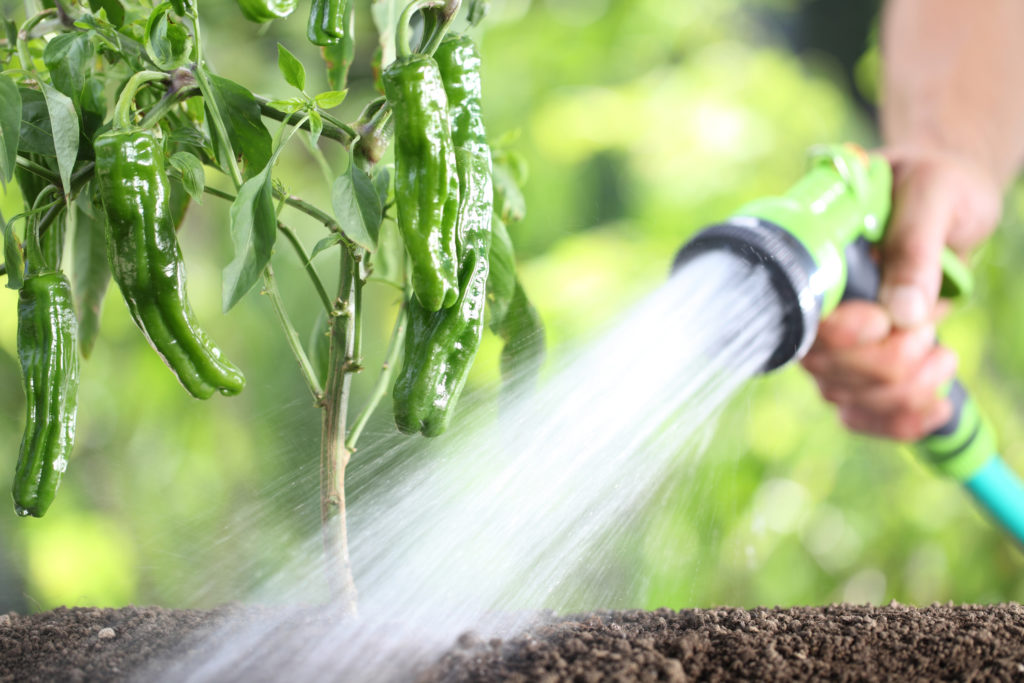
Peppers produce some of the biggest flavors in a vegetable garden. Their vibrant colors can be quite ornamental. Growing peppers is very similar to growing tomatoes, making it easy to grow the two plants together.
Proper planning is essential when growing peppers. The first step is to decide what types of peppers you want to grow. There are many varieties of peppers, in a wide range of colors, shapes, and sizes. Peppers have a number of uses from fresh eating, frying, stuffing, pickling, and more!
Types and Varieties of Peppers

Sweet Pepper Types
Sweet pepper varieties come in a variety of colors including purple, brown, yellow, orange, red, and creamy white. Pepper fruit also comes in various shapes and sizes, from the familiar large bell types to elongated varieties to cute miniatures.
Sweet bell peppers are the most popular and familiar type of sweet pepper. Bell peppers start green and ripen to red, orange, or yellow when the fully mature, depending on the variety. Their sweet flavor is perfect for stuffed peppers and for eating fresh.
Sweet non-bell peppers include those which are elongated in shape but share the same sweet flavor as bell peppers. They are very productive and often out yield bell types, especially in short-season areas.

Hot Pepper Types: Mild to Extremely Hot
Hot peppers have greatly increased in popularity in recent years. This is in part due to the increasing influence of ethnic cuisine. In many countries, such as Mexico, Thailand, Korea, and China, specific varieties of hot peppers are traditionally used to flavor food. Hot pepper varieties can range from mildly spicy to extremely hot. The heat level of hot peppers is measured by the Scoville Scale.
Those unfamiliar with the fiery world of hot peppers may believe that all hot peppers are very similar. On the contrary, hot peppers offer a full taste spectrum and a varied heat spectrum (which is a different sensation than taste). It is important to be aware that pepper growing conditions can influence the heat level of a pepper. Peppers grown in dry or drought conditions will generally produce a hotter flavor.
Growing Peppers in Containers

You can save valuable vegetable garden space by growing peppers in containers. Many pepper varieties adapt well to container gardening and can be combined with annuals in large pots on a deck or patio.
When growing peppers in containers, always use a good quality, well-drained potting mix and choose containers at least 12 inches deep. Plant peppers in a sunny spot that receives at least 6 to 8 hours of sun daily. After planting, fertilize pepper plants every 10-14 days with a fertilizer higher in phosphorus (the second number) than nitrogen (the first number), like ALGOplus Tomato Fertilizer 4-6-8.
Seeding and Hardening Off Peppers
Sow pepper seeds in well-drained seed starting mix, and keep them warm (80 to 86 F) while the seeds germinate. Start the seeds 6 to 8 weeks prior to the recommended date for transplanting to the vegetable garden, which is usually 2 weeks after tomatoes are transplanted. Later transplanting helps to ensure that the weather is warm enough to support the vigorous growth of the pepper plants.
Pepper seeds take approximately 14 to 28 days to germinate. If you want to know how to germinate peppers fast, keep in mind that pepper germination rates vary depending on pepper variety. Hot peppers tend to be slower to germinate than sweet pepper varieties. Be sure you don’t allow your pepper seedlings to suffer from drought or low temperatures as they develop.

Keep your pepper plants growing steadily and gradually harden them off. Approximately 7 to 10 days prior to transplanting peppers to the garden, begin adapting your pepper plants to outside conditions. You can utilize a sheltered location such as a screened-in porch to protect your peppers from wind and sun at first. Then gradually acclimate your peppers to vegetable garden conditions as the weather permits. Hardening off strengthens the pepper plant cell structure and will result in much sturdier and more rapidly growing pepper plants after transplanting to the vegetable garden.
Pepper Growing Tips

Peppers are members of the Nightshade Family, along with tomatoes and eggplants, and thus similar in culture. However, there are a few differences when it comes to peppers. Peppers are more susceptible to cold damage than tomatoes. Never rush to transplant pepper seedlings to the garden, and always make sure all danger of frost and cold weather has passed.
Planting Peppers
Plant peppers with 18 inches between plants and 2 feet between rows. For each pepper plant, dig a hole approximately 6 inches deep and incorporate 2 inches of organic matter into the soil at the bottom of the hole. Set the pepper seedlings lower in the ground than they were in their pots. After transplanting, water thoroughly.
Peppers thrive best in soils rich in organic matter, with adequate moisture. Grow pepper plants in a full sun location, where they receive at least 6 to 8 hours of sun daily. In northern gardens, putting down black weed control fabric or plastic mulch can provide hotter growing conditions peppers like.
Common Pepper Problems
Peppers can develop blossom end rot, a localized calcium deficiency in the fruit. Because calcium moves passively in plants as they take up water, ensure that there are not large moisture fluctuations in the soil to help prevent blossom end rot. Additional calcium can also be applied as a foliar spray or soil drench, using a product like Nutri-Cal Liquid Calcium.

Staking, Weeding, & Mulching Peppers
Staking can be beneficial since pepper plants are brittle. Cultivate often, but not deeply, when weeding to avoid causing root damage. In addition, you can mulch to help prevent weed germination and the loss of moisture.
Harvesting Pepper Plants
To harvest your pepper plants, snap pepper fruits off or cut them off with a knife to prevent damage to plants. Harvest the peppers throughout the season to encourage the pepper plants to continue to set more peppers. Allowing the peppers to ripen on the pepper plants improves the quality and flavor, so you may want to allow some to full ripen on the pepper plants before harvesting while picking some of them throughout the season. With proper care, your pepper plants can produce until frost.
At the end of the season, pick any remaining pepper fruits before the first hard frost. Peppers can be kept on the kitchen counter for a few days to ripen further, but if you have too many peppers to use right away, consider freezing them, canning your peppers, or drying them. Your local extension service should have helpful information on home pepper freezing and pepper canning.
Other Recommended Reading

- 17 Flavorful Pepper Types
- A Gardener’s Guide to Plant Nutrition
- Understanding Plant Diseases
- 11 Watering Tips for Your Garden
At Jung Seed Co, we strive to be your go-to guide for all your gardening needs. Our YouTube channel Jung Garden Center now includes our new video series All Things Green where our experts provide gardening tips for all levels of gardeners. When you need reliable gardening advice, turn to the trusted experts at Jung.
View our new catalog online or browse our website for all of your gardening favorites. To receive info on new products, exclusive deals, and specials, be sure to sign up for our weekly email. Join our Facebook page, to discuss all things gardening!